
15 Dec Why Start Your Pet’s Anesthetic Dental Care at 1-1 1/2 Years Old?
Recent studies indicate that 80% of dogs and cats have some form of periodontal disease by age 3. By definition, periodontal disease (PD) has 4 Stages. Stage 1 is defined as gingivitis (no bone loss); Stage 2 has <25% bone loss; Stage 3 has 26-50% bone loss, and Stage 4 PD is >50% bone loss. As this has been reinforced into our heads by all veterinary dentists, one must look at what this statistic really means, and how this applies to the way we should approach our young dogs and cats.
Some Dog Breeds Are More Prone to Periodontal Disease
Most veterinary dental specialists (AVDC) would also add that the smaller breeds (dogs under 2o lbs) are at a higher risk for periodontal disease due to their small jaw size in relation to all the teeth in the mouth.
Human periodontologists have taught us that saving teeth is directly related to saving bone. If you save bone directly around a tooth, you have a very good chance of keeping that tooth healthy. However, when looking at a small breed pet such as a Pug, Pomeranian, Poodle, Lhasa Apso, Chihuahua, etc… teeth are crowded and double parked with very little bone space between each tooth.
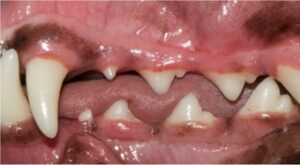
Figure 1. Normal occlusion with adequate space between teeth (courtesy AVDC.org)
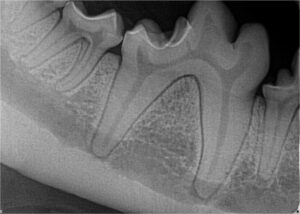
Figure 2. Notice space between teeth as well as enough bone below the roots
The first two pictures of a Labrador retriever compliments of the AVDC. Notice plenty of bone space between teeth. This allows each tooth to have their own ‘house’ of bone to surround a tooth (Figure 1). The radiograph of a dog with normal spacing shows plenty of bone both between and below the teeth (Figure 2).
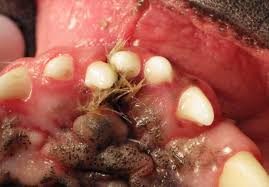
Figure 3. Crowding of incisors that causes secondary inflammation and bone loss.
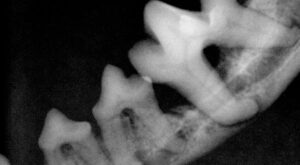
Figure 4. Significant bone loss associated with advanced periodontal disease. There is no bone below the roots. The mandible is highly compromised.
Smaller breed pets can have significant crowding causing inflammation, bone loss and tooth mobility (Figure 3). If one looks at the radiographs of smaller breed pets, the tooth size in relation to the mandible is quite large, leaving very little bone support to house that large 1st molar. This radiograph (Figure 4) is of a small breed pet that has significant bone loss (Stage 4 PD). The root of the 1st molar touches the floor of the mandible. There’s no bone support present and a true recipe for a mandibular fracture under the lightest of bite stress.
Can you appreciate the need to keep those teeth clean to avoid bone loss and potential mandibular fracture? This alone is a very good reason why to start dental care at an early age…prevent aggressive bone loss!
Why You Should Start Anesthetic Dentistry for Your Pet Early
So what should be the standard of care to start anesthetic dentistry? Veterinarians are historically reactive versus proactive so changing that mindset is the key to lifelong dental success. Dental success can be defined as a pet having a quality of life with enough teeth to be functional and happy, while removing any teeth that can compromise this long-term goal. While under anesthesia, assess and remove those crowded teeth if they are compromising a more important tooth nearby. When performed at an early age (around 1-1 1/2 years), this prevents bone loss that may compromise the jaw and surrounding teeth. Once bone loss occurs, it cannot be regrown and this contributes to tooth mobility and eventual loss. Only in certain circumstances can we perform bone grafts to raise height, so once gone…it’s gone.
1. Eliminate Plaque
The first reason you should start anesthetic dentistry at an early age is to start attacking the source of bone destruction and inflammation…plaque. Plaque is an aggregate of bacteria directly underneath the gumline. It is the source of bacteria, that over time, attracts the body’s inflammatory cells to that source. What happens next is a true ‘battle royale’ between the body’s reactive mechanism and that plaque bacteria. Inflammation and bone loss occur. It is these two negative results that lead to tooth mobility. The final death blow is tooth loss.
Therefore, addressing the source of plaque bacteria below the gumline can only be accomplished via using ultrasonic scaling, with or without hand scaling, followed by careful polishing. This must be done professionally by trained personnel. Do not attempt to remove plaque and tartar off a tooth without general anesthesia. The image below is a pet before professional cleaning and after. The visible calculus is removed, but more importantly, the plaque is removed.
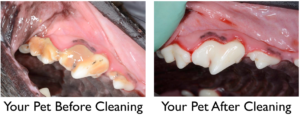
One may ask what about tooth brushing? ‘I brush my pet’s teeth regularly, therefore I don’t need to have my pet’s teeth professionally treated’. While brushing is an important component to overall oral health, the bristles of the toothbrush cannot get significantly below the gumline to remove plaque. The normal gingival sulcus below the gumline is 2-3 mm in dogs. Toothbrushing reaches 1 mm below the gumline. You can then see that while brushing can help some, your pet needs more help.
2. Prevent Cysts
A second reason to perform anesthetic dental cleanings is to check for missing teeth or embedded teeth. There are some teeth that have an affinity to not erupt properly, and left underneath the gumline can cause cyst formation and bone destruction. Once formed, this cyst can expand and cause further damage to teeth close by causing more problems and pain. However, if found early, an embedded (not erupted) or impacted (unable to erupt due to crowding or other issues) tooth can be more easily surgically removed before the cyst forms.
This oral surgery is much less expensive and invasive than the cyst removal and surrounding reconstruction. Which one is better for your pet? Of course, being proactive and identifying those potentially embedded teeth early in life to avoid pain/suffering for them. This also saves you, the pet owner, and a considerable amount of funds. The below image is of a missing tooth followed by the radiograph indicating the tooth is embedded and a cyst formation occurred around it.
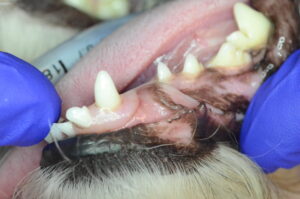
Missing the left mandibular 1st premolar tooth.
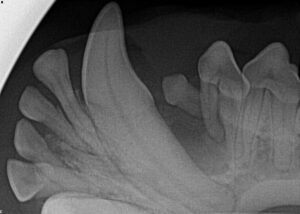
Dentigerous cyst formation of the left mandible associated with an embedded primary tooth. Notice the extensive bone loss involving the canine and 2nd premolar.
3. Maintain Overall Health
Another reason why you should start anesthetic dentistry at age 1 – 1 1/2 years is to come to the understanding that anesthetic dental care is a part of their annual wellness care. Keeping the mouth free of inflammation as best you can is one of the best ways to prevent oral bacteria from entering the bloodstream and affecting distant organs such as the liver, kidneys, lungs, and heart. To me, annual dental care is just as important as an annual physical exam and wellness blood work.
Don’t Wait Until It’s Too Late
In addition, consider this fact. If you don’t start and continue to keep your pet’s mouth free of inflammation, once your pet gets much older, you may lose the chance to treat their mouth because of extreme anesthetic risk. I see this scenario play out so many times where recommendations have been ignored. then later in the pet’s life the owner finally decides to treat their pet, but their pet has a significant underlying disease. That is a tragic situation.
With that vein of thought, some of my most diligent pet owners went through the above scenario and told me afterward that they would NEVER do that again. Once they got a new family pet, they made a pledge to keep their pet’s oral care a priority and addressed their pet’s oral care needs when recommended. Once that pet becomes a super-senior or becomes a high-anesthetic risk for a dental procedure, that’s all right. The mouth is in very good condition and there isn’t any pathology that can cause oral pain or even worse, lead to distant organ pathology such as heart, lung, liver or kidney disease. You’re covered!
Dog and Cat Dentist in Nashville
Therefore, my question to you, the pet owner, is how long do you want your pet to live? If you want your pet to live a long, healthy, comfortable life, then staying on top of oral care is one of the easiest and most rewarding reasons to have anesthetic dental procedures done annually. Give us a call today to schedule your pet’s next dental checkup.
…and don’t forget home dental care. I’ll address that in another upcoming blog.
Barden Greenfield , DVM, DAVDC
Your Pet Dentist of Nashville


